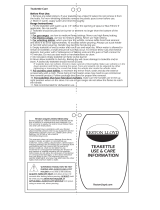
Important Safety Instructions
To reduce the risk of fire, electrical
shock, injury to persons, or damage
when using the range, follow basic
precautions, including the following:
General
@Use the range only for its intended
ORead all instructions before using
use as described in this manual.
the range.
.Install or locate the range only in
accordance with the provided
Installation Instructions. The
Giib
llldll
range must be installed by a qua-
lified installer. The range must be
@Do not touch surface units, areas
properly connected to electrical
near units, heating elements, or
supply and grounded.
interior surfaces of oven. Surface
@@
units and heating elements could
be hot even though they are dark
in color. Areas near surface units
and interior surfaces of an oven
become hot enough to cause
burns. During and after use, do
*WARNING: To reduce the risk
of tipping the appliance, the
appliance must be secured by a
properly installed anti-tip bracket.
To check if the bracket is instal-
led properly, see “The anti-tip
bracket” on page 20.
aCAUTION: Do not store things
children might want above the
range. Children could be burned
or injured while climbing on it.
.Do not leave children alone or
unattended in area where the
range is in use. They should
never be allowed to sit or stand
on any part of the range. They
could be burned or injured.
not touch, or let clothing or other
flammable materials contact
surface units, areas near units,
heating elements, or interior sur-
faces of oven until they have had
sufficient time to cool. Other sur-
faces of the range, such as the
oven vent opening, the surface
near the vent opening, the cook-
top, and the oven door could also
become hot enough to cause burns.
43
‘\
@Do not operate the range if it is
@Do not wear loose or hanging
damaged or not working properly.
garments when using the range.
@Do not use the range for warming
They could ignite if they touch a
or heating the room. Persons
hot surface unit and you could be
burned.
could be burned or injured, or a
fire could start.
comnuea on next page




















